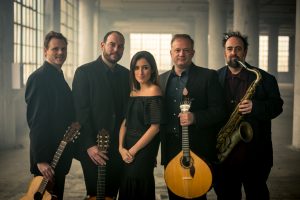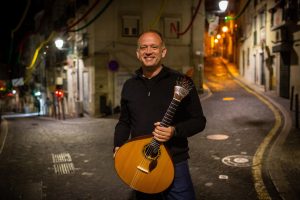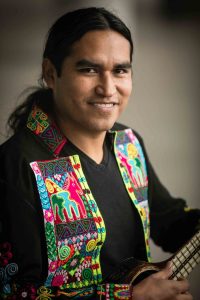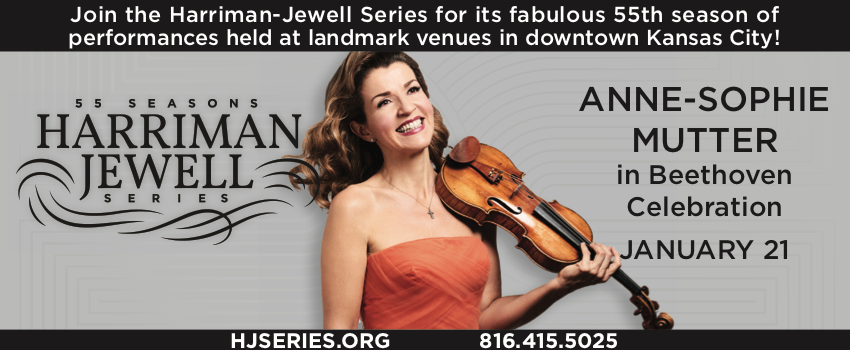Career and family: It is possible to have both, but it takes work. Guitarist Beau Bledsoe is a peripatetic soul by nature, and over the years he has explored the roots of music he loves through travels to Seville (flamenco), Lisbon (fado), Buenos Aires (tango), Istanbul (Middle Eastern styles), and Mexico. More recently he has delved into the confluence of styles that pervades Texas-Mexican conjunto music, and the Country music that surrounded his early years in Little Rock, Arkansas.
But Beau and his wife, Zhanna, are now raising two young children, so things had to change. Long known locally for his central role in such groups as Tango Lorca, Bach Aria Soloists, and Alaturka, six years ago Beau founded Ensemble Ibérica, the name of which says much about Beau’s own lifelong fascination with the traditional Spanish guitar and its origins.

Photos by Jeff Evrard
This December the group presents two programs: Siento y Vivo with flamenco dancer Melinda Hedgecorth (December 8th at Polsky Theatre) and Cruzando featuring Bolivian-born Amado Espinoza performing music of Iberia and the New World (December 20th at St. Paul’s Episcopal Church).
“My activities were sort of splintered around a lot of different things,” Beau said recently. “One of the reasons I started Ensemble Ibérica is that I wanted to be around here more.” He does indeed love being at home these days: Lately he finds himself exploring Country music by singing the kids to sleep with the songs his grandmother used to sing.
Another reason Ensemble Ibérica has become central for Beau is that much of the music he loves is inherent to, and has radiated out from, the Iberian Peninsula: not just Latin America with its indigenous mixtures, but also Moorish Spain and its Middle Eastern influences. “For me it was sort of the first ‘world wide web,’ ” Beau said, with a laugh, of the ship-lines that took Iberian culture throughout vast stretches of the globe during periods of colonization.

Beau Bledsoe in Alfama, Portugal
By playing what he calls the Spanish guitar, Beau can cover a wide range. (It is essentially the “acoustic guitar,” the instrument with six strings tuned to E-A-D-G-B-E that many of us have strummed at some point in our lives.)
“That was the idea of Ensemble Ibérica, that it can be a big enough umbrella to get everything in.” But Beau has also devoted enormous energy to learning the Portuguese guitar with its complex tuning system (toward performing Lisbon’s highly expressive fado music) and the pear-shaped Middle Eastern oud lute (toward playing Turkish music).
And although he has traveled the globe, Beau does prefer to revisit his favorite places, rather than try to hit as many cities and countries as possible. “It’s more about cultivating relationships,” he said, “often in small towns that are barely on the map but have deep, deep roots in tradition.”
He has played a wide range of instruments throughout his life, and though his focus is on Spanish tradition his explorations have recently taken in him to the Portuguese guitar. “Yes it has six strings,” he said, “but they’re turned in a really strange way.” This instrument also comes with its own repertoire, both for solo guitar for accompanying fado singers.

Amado Espinoza
To learn this, Beau did what he usually does: He picked up and went to Lisbon and studied the music from the source itself. In this case it was Sidónio Pereira, a prominent fado artist who died in 2014 but not before imparting a great deal of knowledge to Beau as to many others. “We just met in a fado house once a day, and he took me through all the forms and how to do them,” Beau said. “It’s just hundreds and hundreds of songs, most of them about the ocean.”
Likewise in Seville, Beau explored the multifarious traditions of Spain, from the present-day resurgence of interest in the “modern” guitar to the ancient Moorish traditions of the ninth-century music-master Ziryab, a native Baghdadi singer and oud virtuoso who served in the nearby court of Cordova and exerted a major influence on much subsequent Iberian music.
“He was sort of a rock star,” Beau said of Ziryab. “People still talk about him as if he were still alive. … A lot of the flamenco guitar technique comes from him.” But the elements of this tradition are infinitely more complex, especially for those trained in “Western” traditions, Beau added. “They have a whole different scale system, and the rhythms are very complex. … Their music treatises look like chemistry textbooks.”
It’s a long way from the Ouachita Mountains of Arkansas, but Beau said that the more he explores the world’s folk traditions, the better he understands the “hillbilly” music he grew up on. “So, when I started singing to my kids, it was not fado, it was the stuff that was around when I was growing up.”
Much of this music lay dormant in his brain, he said with a laugh, until he began to sing it around the house. “Having kids … and being older now, those life-cycles you know? … it all came roaring back, and now I love ‘my own music’ again.” Beau describes own family background as humble and filled with the sort of communal music-making that was found throughout the South during the early 20th century. The Bledsoes were not exactly the Carters, Beau said, “but our extended family reunions sometimes kind of looked like that.”
After studies in his native Arkansas, Beau worked with Douglas Niedt at UMKC, who had himself been a student of the legendary Segovia disciple José Tomás in Spain (one of the primary progenitors of Spanish guitar tradition in the second half of the 20th century).
But for Beau that was just the first step in learning a whole array of styles that largely emanated from the “threads” of Iberian traditions. “The more I would pull on those threads, the more I would end up in an environment that people in academia could consider a ‘folkloric’ environment,” Beau said. “Which is really everything outside of academia.”
Thus from Spanish guitar traditions he learned early in life, he expanded to the fado and Sidónio, and he continues to explore the roots of tango and its folklore, most recently through a patron trip to Argentina and Uruguay this fall.
These trips not only introduce Ensemble Ibérica audience members to musical sources, they explore out-of-the-way places where few tourists have tread. “It’s something you could not buy,” Beau said, “something incredibly intimate that you’ll remember your whole life.”
* Siento y Vivo (I Feel and Live), presented on the Carlsen Center’s “Winterlude” Series, features dancer/choreographer Melinda Hedgecorth, violinist Coleen Dieker, percussionist John Currey, and guitarists Beau and Michael McClintock; it is on December 8th at Polsky Theatre, JCCC. For tickets call 913-469-4445 or go to jccc.edu/carlsen-center-presents.
* Cruzando (Crossing), which explores a mixture of European and indigenous music of the New World, features Amado Espinoza (flutes, charango, percussion), Beau (guitar), Molly McLaughlin (vocals, flute), Brandon Draper (percussion) and Coleen Dieker (violin); it is on December 20th at St. Paul’s Episcopal Church. For tickets call 816-471-5107 or go to ensembleiberica.org.
To reach Paul Horsley, performing arts editor; send an email to paul@kcindependent.com or find him on Facebook (paul.horsley.501) or Twitter (@phorsleycritic).
